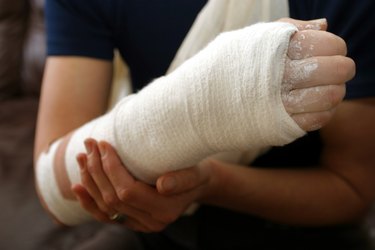
A broken arm isn't an excuse to skip your workouts. In fact, your doctor might recommend broken arm rehab exercises and stretching to speed up healing. Generally, you can exercise your fingers, elbows and other joints that are not covered by the cast.
Tip
If you're wearing a cast, you may still be able to exercise your thumb and fingers or the opposite arm. Once the cast is removed, your physiotherapist may recommend gentle exercises to strengthen your arm and restore its mobility.
Video of the Day
Arm Fractures: What to Expect
Arm fractures may involve the ulna, humerus or radius. One or more bones can break or crack due to falls, injuries or direct blows, notes the Mayo Clinic. Certain sports, such as football and skateboarding, may increase your risk of breaking an arm. Osteoporosis and other conditions that weaken the bones can lead to arm fractures too.
Video of the Day
However, this doesn't mean you should stop working out altogether. Even if your arm is broken, you can still work your core muscles and lower body. Plus, your doctor may recommend physiotherapy for a broken arm to restore your mobility.
A few weeks after your cast is removed, it's recommended to do exercises that stretch and strengthen the arm muscles, points out the Mid Cheshire Hospitals NHS Foundation Trust.
Beware that a broken arm takes time to heal. In severe cases, you may need to wear a cast for up to three months. Forearm and humerus fractures may require up to six months of rehab exercises, states Harvard Health Publishing. Generally, physical therapy is prescribed as soon as the affected bone begins to heal.
Physiotherapy for a Broken Arm
The role of physical therapy is to restore your strength and mobility. Many times, the bone needs to be immobilized or stabilized after a fracture. However, you may still be able to do simple exercises for your wrist or fingers.
A physical therapist will not only recommend broken arm rehab exercises but also show you how to use assistive devices. He or she will also assess your strength, flexibility, gait and range of motion to determine which exercises are safe and which ones to avoid.
The cast may affect arm strength and mobility, making it harder to resume your activities after healing. For this reason, it's recommended you do gentle exercises and stretches while wearing the cast, states the NHS. As a rule of thumb, avoid any movements that put weight or strain on your arm.
Your physiotherapist may recommend ROM exercises shortly after surgery. Their role is to reduce stiffness and help your bones get used to the loads that you may encounter in your daily life. You should be able to move your shoulders and straighten or bend your fingers while in a cast. Simple movements, such as rolling your shoulders forward and lifting your arm toward the ceiling may prevent your arms and fingers from stiffening up.
Broken Arm Rehab Exercises
The Mid Cheshire Hospitals NHS Foundation Trust recommends a combination of stretching, strength, flexibility and ROM exercises to recover from injury. Occupational therapy and sport-specific therapy may help too, depending on your individual needs. What matters most is that you strengthen the muscles surrounding the affected bone and restore your range of motion.
The truth is most people don't do much exercise while in a cast, which can lead to muscle atrophy. If your arm still hurts, consider training the other arm.
A small study published in the Journal of Applied Physiology in April 2018 suggests that unilateral strength training may help preserve muscle thickness, strength and volume in the opposite immobilized arm. Researchers believe that training one arm may cause "mirror" contractions in the opposite limb, but further investigation is needed to confirm these findings.
As you begin to heal, you may incorporate gentle exercises into your routine. Your training program will depend on the type of fracture. Oxford University Hospitals, for example, recommends the following broken arm rehab exercises for radial head fractures, which affect the part of the bone near the elbow:
Move 1: Elbow Flexion/Extension
- Stand up or sit on a chair with your arms by your sides
- Bend the affected elbow fully and then straighten it back
- Use the other hand for support to help your arm bend and straighten
Move 2: Supination/Pronation
- Place your forearm on a table
- Turn your palm up and down without moving your elbow
Perform 10 repetitions for each exercise, three to four times a day. Hold each position for five seconds or so.
If you broke the ulna or the long forearm bone (radius) at your wrist, try the following exercise as soon as your cast is removed:
Move 3: Wrist Flexion
- Place your forearm on a table with your hand over the edge
- Bend your hand up and down from the wrist
You may also exercise your thumb and fingers to maintain your mobility. For example, you can touch your thumb to the tip of each finger as quickly as possible. Another option is to make a tight fist, straighten your fingers and repeat. Do these exercises daily to reap the benefits.
- Mayo Clinic: "Broken Arm"
- ASSH: "Broken Arm"
- Mid Cheshire Hospitals NHS Foundation Trust: "Fracture Exercises"
- Harvard Health Publishing: "Arm Fracture"
- NHS: "Broken Arm or Wrist"
- Journal of Applied Physiology: "Unilateral Strength Training Leads to Muscle-Specific Sparing Effects During Opposite Homologous Limb Immobilization"
- Oxford University Hospitals: "Helping Your Elbow to Recover After a Radial Head Fracture"
- Oxford University Hospitals: "Helping Your Wrist to Recover After a Fracture"